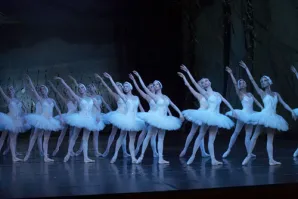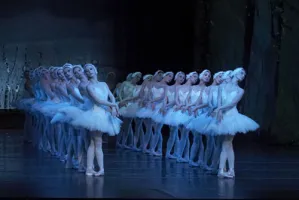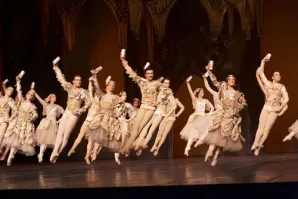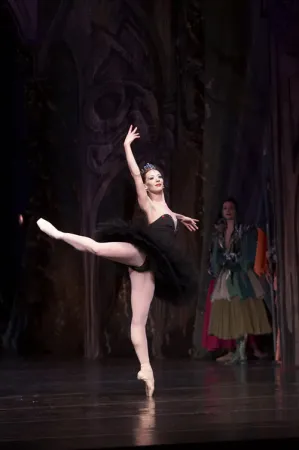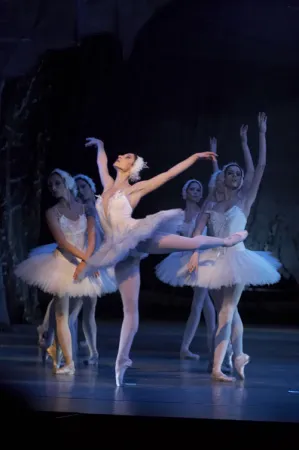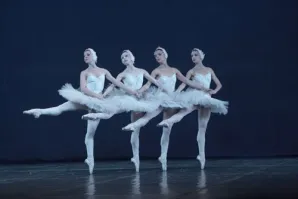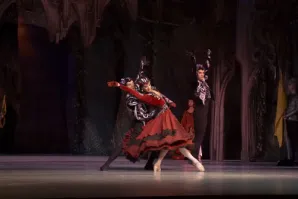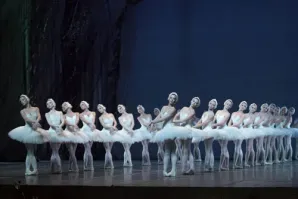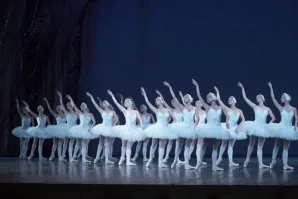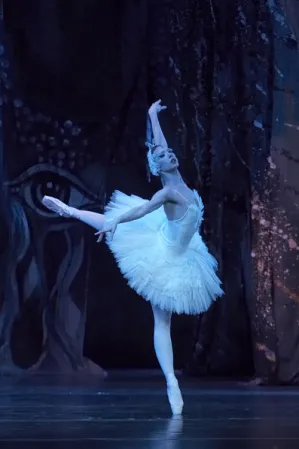Swan lake
ballet by P. I. Tchaikovsky
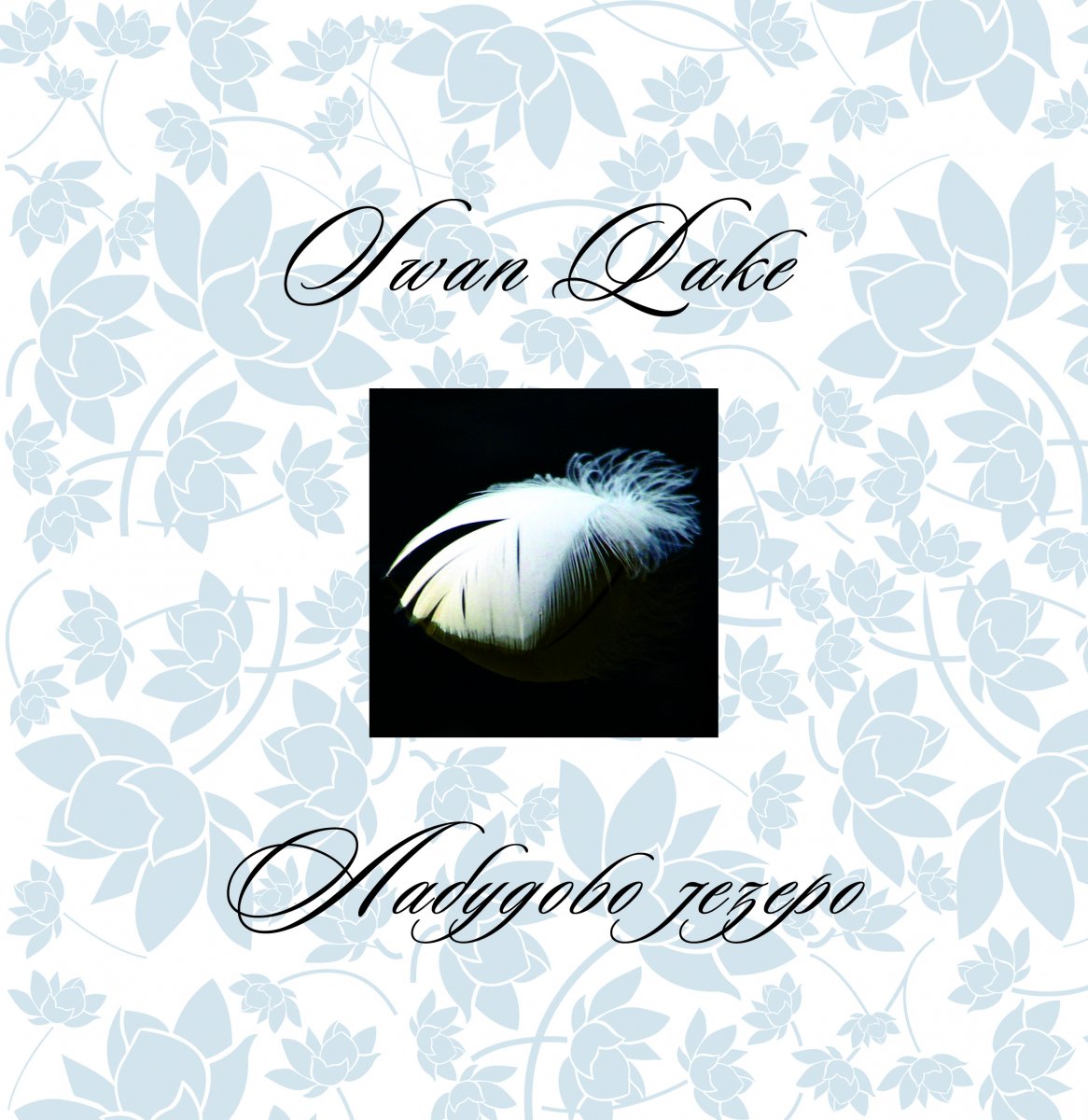
BALLET ABOUT THE POETRY OF DYING
The very first performance of the SWAN LAKE in Julius Reisinger’s choreography took place in Moscow in 1877 and it was not a great success. After composer’s (Peter Ilych Tchaikovsky) death, Lev Ivanov and Marius Petipa staged a new version of this ballet in the Mariinsky Theatre in St. Petersburg in 1895. Tchaikovsky could not have known that his ballet would become esoteric, magic, strongly expressive and the most often performed ballet in the history. All the ballet companies in the world, those that follow the aesthetics of the classical academic style, stage the SWAN LAKE. It can be said that today, on many stages throughout the world, many versions are performed. There are those that are traditional, modernized, those with psychoanalytic interpretation, but they all maintain classical form. Modern choreographers seek radical, modern solutions, and as an inspiration for a new version, only one insight into the essence is enough. The idea of an enchanted princess who was turned into a swan by an evil spirit and who can be saved only by a true love is the archetype of a Russian folk tale. An oath as a temptation of love and deceit, maturing through decision making, human hypocrisy, sacrifice, uniting in fictional death and an apotheosis to an ideal love that is the essence of the SWAN LAKE. The first and the third acts, which were conceived by M. Petipa abound in: pastorals, dances of life, different folk dances, but there is also a hint of death. Fascinating and virtuous Odile is a symbol of temptation. The second and the fourth acts are the choreographic paradigm of Lev Ivanov’s poetry, who creatively wove the Russian elements and the classical harmony into the ballet technique, entering of series of swans in the second act is a stylization of the Russian choirs. Odette and Prince’s adagio is the substance of love, the eternal union of two beings, while the little swans’ dance represents the unbreakable friendship. Three swans are the symbol of femininity, and Odette’s solo dance is the faith in love and salvation. The fourth act is the apotheosis of the beauty of love and immortality. In every movement of a body Ivanov found a symbolic expression, full of drama and poetry. The first performance of the SWAN LAKE in the Belgrade ballet was staged in 1925 in Alexander Fortunato’s choreography. The leading roles were danced by Jelena Poljakova, Nina Kirsanova and Alexander Fortunato. This version was performed over a hundred times till the Second World War. Nataša Bošković and Margarita Froman also became famous by dancing in this ballet, and Marina Olenina, Janja Vasilieva, Anica Prelić, Nada and Andja Arandjelović tried their luck in this role. Sergei Streshniev, Maks Froman, Anatoli Zhukovski and Miloš Ristić danced the role of a Prince. In the redaction from 1951, Nina Kirsanova relied on Alexander Fortunato’s version. The leading roles were danced by Jovanka Bjegojević, Vera Kostić and Branko Marković. This version was on the repertoire for almost twenty years and many ballet dancers took part in it: Milica Jovanović, Ivanka Mikić, Katarina Obradović, Lidija Pilipenko, Milan Momčilović, Stevan Grebeldinger, Žarko Prebil and Gradimir Hadži-Slavković. The great international prima ballerinas Maya Plisetskaya and Margot Fonteyn were guest-stars in that ballet. In 1970, Dimitrije Parlić, in co-operation with Kzhishtof Pankievich, the set and costume designer from Poland, created his version of the SWAN LAKE. Тhe leading roles at the premiere were performed by Dušica Tomić, Lidija Pilipenko and Radomir Vučić. In the second act of Lev Ivanov, Parlić kept the choreographic entirety, with certain choreographic interventions, the first and the third acts were created by himself. The SWAN LAKE in Dimitrije Parlic’s choreography had the exceptional success. It was performed 227 times. Višnja Djordjević and Borivoje Mladenović danced in the second showing. For many years Ivanka Lukateli danced as Odetta and Odile, then, Ljiljana Hmela, Jelena Šantić, Vesna Lečić, Ljiljana Šaranović, Milica Bijelić, Duška Dragičević, Ashen Ataljanc, Ana Pavlović, Mila Dragičević; in the parto of Prince: Aleksandar Izrailovski, Dusan Simić, Ranko Tomanović, Konstantin Tešea, Nenad Jeremić, Konstantin Kostjukov, Denis Kasatkin, Jovan Veselinovć. In the history of the SWAN LAKE at the stage of the National Theatre, the version of Dimitrije Parlić left the strongest artistic impression. Revival of this version of the SWAN LAKE in 1998 is a tribute to the great Serbian choreographer, and also a sign of great aesthetic values.
Jelena Šantić
Prepared by M.D.
 PETER ILICH TCHAIKOVSKY (1840-1893)
PETER ILICH TCHAIKOVSKY (1840-1893)
„One can not say what is the most admirable thing in Tchaikovsky’s work: the symphony value of his ballets, their dancing qualities or the strength of expression and emotion. They are real dancing dramas.”
Serge Lifar
While searching for vivid, real dramatics and psychologic truth in opera, Tchaikovsky thought that ballet art was represented by fantasy of a fairy-tale. In this sense Tchaikovsky follows the line of the romantic ballet that is based on numerous fantastic scenes and theatrically-expressive effects. He has creatively understood and approached the problem of ballet, therefore reforming the traditional basis of this genre. Tchaikovsky followed two main lines in developing style characteristics of the romantic ballet. First of all, he has made the pure choreography principale by extraordinary elastic and characteristically diverse. Tchaikovsky renovates the already known types of dance giving them extraordinary freshness and abundance of rhythmics and music plasticity, and, at the same time, showing a great talent for finding out the characteristic forms of dance movements of modern French ballet, and, especially, the art of Delybe, whom he appreciated very much. Another Tchaikovsky’s novelty in the area of ballet music was the development of symphony mime elements. Tchaikovsky has shown the way to ballet symphonization, the path later followed by Glazunov and Stravinsky in Russian music, and, in France, by Ravel and his followers. Tchaikovsky is probably best known for his ballets which he composed in his mature years and those ballets brought him the recognition of his contemporaries. 1872 Swan Lake - op.20 - his first ballet performed at first with some shortcomings (faults) which would be straighten out later on. First performance in the Bolshoi Theatre. 1890 The Sleeping Beauty - op.66 - Tchaikovsky himself thought this ballet to be his best. First performance in Mariinsky Theatre in Sankt Petersburg. 1892 - Nutcracker op.71 - The composer was not terribly pleased with his last ballet. Tone poem Francesca da Rimini, op 32 . It was composed in Bayreuth in the autumn of 1876, in a very short period of time, inspired by the episode from Dante’s The Divine Comedy.
 DIMITRIJE PARLIĆ choreographer (1916-1986)
DIMITRIJE PARLIĆ choreographer (1916-1986)
A visionary between classical tradition and modern sensibility. The great ballet artists in their artistic memory also have the sense of the time they live in. Dimitrije Parlić gave immense contribution to the Yugoslav culture by bringing the spirit of modern Europe of the fifties and sixties. He initiated many modern forms and movements not only in Belgrade, but also in Yugoslavia. He undeniably influenced the new life, which was emerging behind the socialrealism. Even in those years Parlić created ballets on music of Prokofiev, Stravinsky, Bartok...
The choreographic work of Dimitrije Parlić is very versatile. He created ballets classical in form, with clear story, symmetrical in structure, with neo-classical vocabulary of dance. One-act creations, modeled after fokinian and post-fokinian ballet, make a large opus. The artist occasionally experimented with the abstract form. Within the limits of a given form, Parlić always followed the firm staging and dramaturgy path and it was the highest value of his work. He told a story by means of director’s solutions in which the movements of the body followed the concept of the performance. He almost entirely abandoned the pantomime. In that way he managed to come closer to a modern sensibility even in classical ballets. He found inspiration for his pieces in fairy tales, myths, legends, contemporary stories and dramatizations of well-known literary works. Dimitrije Parlić chose various genres: ballet dramas, melodrama, comedies and pastorals. Within these frames he created his new, modified world. Especially important parts of his work are choreographies based on music of our composers and his understanding of stylizations of folk dances of Macedonia, Croatia and South Serbia. Knowingly, imaginatively, he incorporated folklore elements into ballet technique and even went one step further. He found new, modern ballet expression in abstracting of those elements and motifs, and in them he maintained the spirit of the Yugoslav clime. In scenic solutions, Parlić often used objects of symbolic values: a mirror is a virtual reflection of a person who rejected himself, a cage is a sign of losing a precious freedom, a crown is a justification for others and for yourself, an eye is all-inclusive look of the world, and a symbol of a divine cognition, a ball contains the wholeness of a world in which there is no beginning and no end, a mask is an archetype of nature and its double. In order to achieve the complexity of the interpretation of life, Parlić introduces characters of destiny, vision, youth and angels. The creative world of Dimitrije Parlić includes the real characters mythological and fanciful creatures that in imagination float in an area filled with love, jealousy, hatred, revenge, threats and death. He built characters with a refined feeling, he made characterization with nuance, and each role had the right part in the composition of a work as a whole. Great artist grew with this great choreographer and they inspired Parlić with their skill: Rut Parnel, Jovanka Bjegojević, Duška Sifnios, Višnja Djordjević, Lidija Pilipenko, Dušica Tomić, Ivanka Lukateli, Dušan Trninić, Milan Momčilović, Branko Marković, Stevan Grebeldinger, Žarko Prebil, Borivoje Mladenović, Rade Vučić, Dušan Simić and others. Director of the Opera and a conductor Oskar Danon was a strong support for Parlić. This mutual exchange of energy and art resulted in the anthological ballets on the stage of the Belgrade Ballet. Parlić paid special attention to the visualization of the performance. As associates he chose people who themselves were strong authors: Vladimir Zhedrinsky, Dušan Ristić, Milo Milunović, Mića Popović, Kzhishtof Pankievich, Kolja Milunović and others. Dance is not the only axiom around which Parlić created his world, there is also a universal syncretic theatrical beauty, which consists of dance, music and scenic visualization. Logic, strength, coherence of the internal, binding forces and woven poetry gave harmony and beauty to Parlić’s creations. His ballets convey the idea that a man is what he is, and that idea expressed his humanistic cognition of ballet. Threads of sensual feeling permeate through his entire creative work. And for that reason it can be said that Parlić is a true artist who synthesized the language of ballet and reality, full of artistic imagination, creating a more modern world. With his work Parlić made the first breakthrough with modernism and democracy in the culture of Belgrade and Yugoslavia in the fifties.
Jelena Šantic, 1998
METAMORPHOSES OF “SWAN“
1877 - Moscow, the Russian Imperial Ballet. World premiere of Peter Ilych Tchaikovsky’s SWAN LAKE, with choreography by Julius Wentzel Reisinger. Libretto was written by Vladimir Begichev, dramaturge and the intendant of the Russian Imperial Theatres in Moscow and Vassili Geltser, dancer. However, the premiere was a flop.
1880 - Moscow. New version of SWAN LAKE, with choreography by Joseph Hansen.
1888 - Prague, the National Theatre. First production of SWAN LAKE outside Russia, with choreography by Augustine Berger. Only the second act of SWAN LAKE was then given, but in the presence of composer.
1889 - St. Petersburg, the Russian Imperial Ballet. World premiere of Peter Ilych Tchaikovsky’s THE SLEEPING BEAUTY, with choreography by Marius Petipa.
1892 - St. Petersburg, the Russian Imperial Ballet. World premiere of Peter Ilych Tchaikovsky’s NUTCRACKER, with choreography by Lev Ivanov, after the libretto by M. Petipa.
1893 - St. Petersburg. Owing to the great success of the above-mentioned ballets, the Director of the Imperial Theatres commissioned Lev Ivanov and Marius Petipa to prepare new full-evening production of SWAN LAKE. Petipa assigned the staging of the second act of SWAN LAKE to Ivanov.
1894 - St. Petersburg, the Maryiinsky Theatre (later known as the Kirov). A year after Tchaikovsky’s death, in the evening organized in honor of the first anniversary of the composer’s death, the second act of SWAN LAKE was performed with Pierina Legnani as Odette. It was a great success both for the choreographer and the ballerina.
1895 - St. Petersburg, the Maryiinsky Theatre. The first full-length production of SWAN LAKE, with choreography by Lev Ivanov and Marius Petipa. This edition has served as the definitive version from which nearly every staging has been based, having been mounted by many noted balletmasters and choreographers from the late 19th century until the present day.
1901- Moscow, the Bolshoi Theater. New redaction of SWAN LAKE, with choreography by Alexander Gorsky. It was an important event regarding implementation of symbols and establishment of classical academism.
1911- London, Les Ballets Russes, the legendary troupe founded by Sergei Diaghilev presented their version of SWAN LAKE, with choreography by Mikhail Fokine, after Ivanov and Petipa. Main roles were interpreted by Matilda Kshesinskaya and Valslav Nijinsky. That same year, in New York, at the Metropolitan Opera, a troupe founded by Mikhail Mordkin, presented the first American production of SWAN LAKE.
1912- Monte Carlo. New production of SWAN LAKE in interpretation of Sergei Diaghilev’s Ballets Russes.
From this year onwards, Ballet Company founded by Rene Blum – Ballet Russe de Monte-Carlo – used to stage this ballet regularly, however always in short version.
1920- Moscow, the Bolshoi Theater. Alexander Gorsky staged new version of SWAN LAKE, in cooperation with Nemirovich-Danchenko and added to it a novelty - character of the Fool. This version lived for a long time on Moscow’s stages.
1921- Moscow, the Bolshoi Theater. New version by Asaf Messerer, which had a great influence on later productions.
1925 - The National Theater of Belgrade launched the full-length production of SWAN LAKE, with choreography by Aleksandar Fortunat.
1933 - Leningrad, the Kirov Theatre. After 38 years, a version by Petipa-Ivanov was replaced with a new one by Agrippina Vaganova and Vladimir Dmitriev. The original scheme and the second act by L. Ivanov remained the same, but a character of Beno was omitted.
1934 - London, Vic-Wells Ballet. First production of the full-length version of SWAN LAKE in Great Britain, with choreography by Nicholas Sergeyev, after the version by Petipa-Ivanov.
1936 - Paris, the Opera. Serge Lifar presented to the Paris audience his fragmental version of SWAN LAKE.
1945 - Leningrad, the Kirov Theatre. New version of the ballet, with choreography by Fedor Lopukhov, after the version by Petipa-Ivanov.
1951 - The New York City Ballet. Production of the second act, with choreography by George Balanchine.
1953 - Moscow, The Stanislavsky and Nemirovich-Danchenko Music Theatre. Vladimir Bourmeister designed a new version that is still in repertoire of this theatre.
1960 - Bourmeister staged the same version for the Paris Opera Ballet, the first French company to produce this ballet after the original score.
1963 – Stuttgart, Ballet of the Wurttemberg State Theatre. In his dramatization John Cranko highlighted the role of Prince. A great number of modern choreographers accepted his approach to dramatization.
1964 – The Vienna State Opera Ballet. In his version Rudolph Nureyev also highlighted the role of Prince.
1966 - Toronto, the National Ballet of Canada. In his version Erik Bruhn highlighted the negative character of Count Von Rotbart.
1969 - Moscow, the Bolshoi Theater. New version of SWAN LAKE, with choreography by Yuri Grigorovich. The second and the fourth acts were taken from the version by Petipa-Ivanov. Dances of the third act were danced on the toes.
1976 - The Hamburg Ballet. A new version of SWAN LAKE by John Neumeier, in the style of contemporary dance expression.
1987 - Stockholm, the Cullberg Ballet. Through certain modification of the libretto and modern dance technique, Mats Ek took a radical turn from traditional interpretation.
1996 - London. Mathew Bourne showed his new conceptual version of the ballet, based on the original score. The second and the fourth acts were set for male dancers only. French choreographer Roland Petit, founder of the National Ballet of Marseille poeticized male swans’ dance thus reorganizing the original score.
Although approaching its 150th anniversary SWAN LAKE, as a ballet paradigm, remains original enough to bear the epithet of the most famous ballet performance; at the same time it made the art of ballet much more appealing to wider audiences. Despite the fact that it had left royal theatres, SWAN LAKE kept “elitism” of academic order and virtuosity, and remained everlasting inspiration both for the artists and the audience.
Miloš Dujaković
Premiere performance
Premiere, 14th May 1970
Premiere revival 23rd April 1998 / Main Stage
Ballet in four acts
Choreography Dimitrije Parlić
Libretto Vladimir Begičev i Vasilij Gelcer
After Stage Design by Kžištofa Pankijeviča
Set Designer Boris Maksimović
Costume Designer Katarina Grčić
Conductor Dejan Savić
Premiere cast:
Odile / Odette Duška Dragičević
Prince Siegfried Konstantin Kostjukov
Queen Mirjana Stamenković
Count Rothbart Nenad Jeremić
Fool Svetozar Adamović
Wolfgang Ratko Petrović
I Act
Pas de trois Milica Bezmarević, Mila Dragičević, Konstantin Kostjukov
Grande waltz
Solo Jasna Paunović, Ružica Jovanović, Milena Jauković, Olivera Gavrilov, Nebojša Stanković, Miloš Dujaković, Božin Pavlovski, Goran Stanić
Corps de ballet Margareta Bata, Vera Radenković, Bojana Leko, Iva Janketić, Nataša Komarić, Ljupka Stamenovski, Drina Durić, Ivana Glišić, Igor Karakaš, Jovica Mitrović, Nenad Butorović, Srđan Mihić, Duško Mihailović, Igor Miloš, Mihailo Stefanović, Aleksandar Ilić
II Act
Pas de quatre Dalija Imanić, Maja Veljković, Ivana Komarić, Tamara Ivanović
Pas de trois Mila Dragičević, Jasna Paunović, Kosovka Radić
Corps de ballet (in II and IV act) Mirjana Atanacković, Margareta Bata, Maja Veljković, Olivera Gavrilov, Ružica Jovanović, Ivana Glišić, Drina Durić, Irena Zbornik, Tamara Ivanović, Iva Ignjatović, Iva Janketić, Milena Jauković, Vera Radenković, Nataša Komarić, Maja Marković, Lidija Pavlović, Ljupka Stamenovski, Lidija Darmanović, Ana Milić, Željka Mišković, Verica Stanojević, Jelena Momirov, Irina Ivić
III Act
Waltz Bride Marija Vještica, Kosovka Radić, Milena Jauković
Spanish Dance Svetlana Marković, Nebojša Stanković, Goran Stanić
Tarantella Tamara Antonijević, Miloš Dujaković, Igor Karakaš, Ivana Komarić, Irena Zbornik, Ljupka Stamenovski, Lidija Pavlović
Csardas Tatjana Popović, Srđan Mihić, Maja Marković, Mirjana Atanacković, Ivana Glišić, Drina Durić, Jovica Mitrović, Aleksandar Ilić, Dušan Mihailović, Mihailo Stefanović
Mazurka Ružica Jovanović, Vera Radenković, Tamara Ivanović, Božin Pavlovski, Goran Stanić, Igor Karakaš
Orchestra of the Opera takes part in the performance
Concertmasters Balint Varga, Iskra Uzelac
Solo cello Ilona Necić, Vladimir Alnotović
Solo harp Milena Stanišić, Natalija Ristić
Solo trumpet Predrag Necić, Moma Petričević
Lighting Design Boris Maksimović, Petar Alagić, Lidija Pilipenko
Music Associate Sviatislav Rjabov
Organizer Slobodanka Popović
Screenplay Vesna Petrović
Assistant Costume Design Marina Stepanov, Nevenka Marinković
Assistant Set Designer Miraš Vuksanović
Make-Up Nijaz Memiš
Set crew Chief Dimitrije Radinović
Props Dejan Janković
Décor and costumes were manufactured in the National Theatre’s workshops


